One of the rarest Supermarine Spitfires surviving is also one of the last constructed and it resides here in Australia at the RAAF Association Aviation Heritage Museum, Bull Creek, WA.
The Mk 22 Spitfire was powered by the Rolls-Royce Griffon 65 supercharged V12, 2,050 hp (1,530 kW) at 8,000 ft (2,438 m which drove an 11 ft (3.35 m) diameter five-bladed Jablo-Rotol propeller. The aircraft was fitted with four 20mm Hispano II cannon with 150 rpg. This later Mk of aircraft was not as nice a handling Spitfire as previous versions but was quite fast and went into service with 1 RAF Sqn and 12 reserve Sqns. The Mk 22 served the RAF until 1955 when they were retired and the majority sold on to Southern Rhodesian, Egyptian and Syrian Air Forces.
The Mk 22 was very similar to the Mk 21 except the Mk 21 had a high back fuselage and the Mk 22 had the bubble style. 287 Mk 22 Spitfires were produced.The performance was very lively and the Mk22 achieved a top speed of 446 mph (718 km/h; 388 kn) in FS supercharger gear at 29,500 ft. 391 mph in MS supercharger gear at 5,500 ft. The Bull Creek Spitfire is the only Rolls Royce Griffon engine Spitfire on display anywhere in Australia although another earlier Mk is under flying restoration in Queensland.
- Mounted on a pole
- After removal from pole display
- Photo Collage of Spitfire Mk22 PK481
- At the Aviation Heritage Museum
The Bull Creek Mk 22 is RAF serial Number PK481, construction number CBAF.70 and was built at the Vickers Supermarine plant at Castle Bromwich in 1945 and served in the RAF. It entered service on September 3, 1945, and served with several squadrons including 611 before being withdrawn from service in 1953. Following retirement from the RAF the aircraft was acquired by the Brighton & Hove Branch of the Royal Air Force Association in the UK for display and remained with them until 1958 when it was sold on to the RAAF Association, Perth, WA where it was received in 1959 and placed on display mounted on a pole outside the Associations headquarters in Perth and then Bull Creek until 1977. The aircraft was by then looking a little tired and faded so the decision was made to replace it with a fibreglass replica of Mk. XVI, 1985 sourced in New Zealand..
PK481 was then fully refurbished and finished in the fictitious AF-A squadron codes (derived from Air Force Association) (611 Sqn would have had the codes FY, GZ or RAR applied to it).
The Spitfire now resides indoors and looks fantastic displayed in accurate camouflage colors, a fitting tribute to the last of the Spitfire generations. We are very lucky to have this aircraft in Australia as a contrast to the earlier Mk’s of Merlin engine aircraft displayed elsewhere in the country.
Find out more about the Aviation Heritage Museum at Bull Creek WA.
Photo acknowledgements:
- Sid Nanson
- Geoff Goodall’s Aviation History
- Aviation Heritage Museum Bull Creek, WA
- Aviation WA
© John Parker 2017

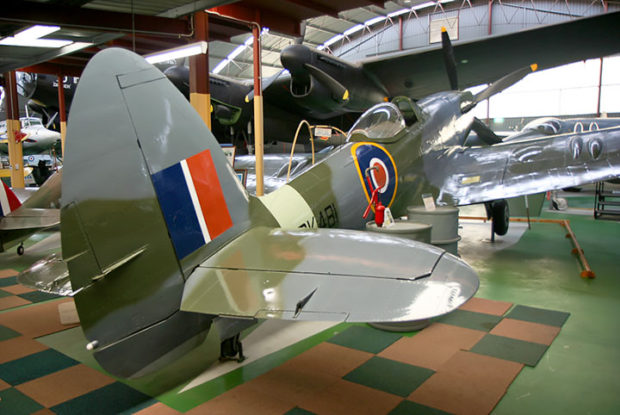
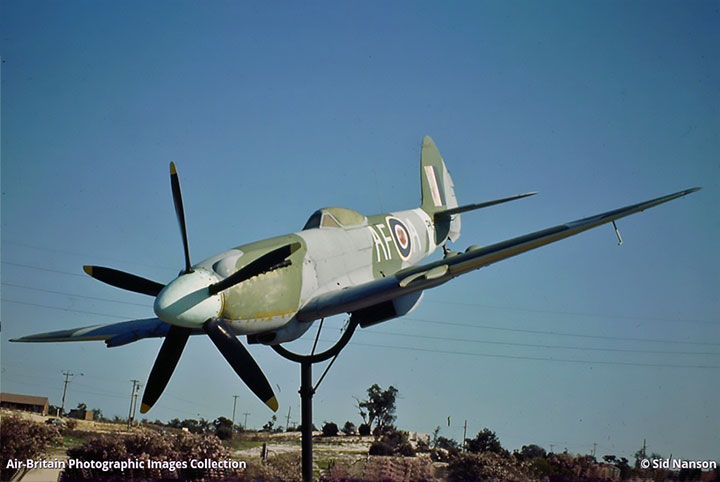
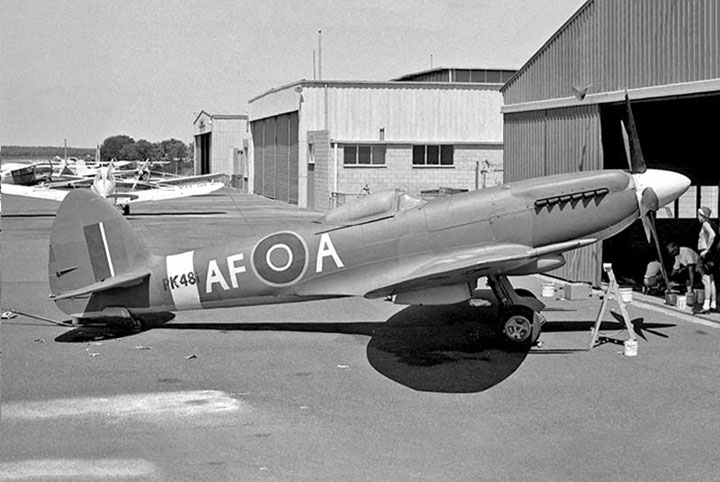
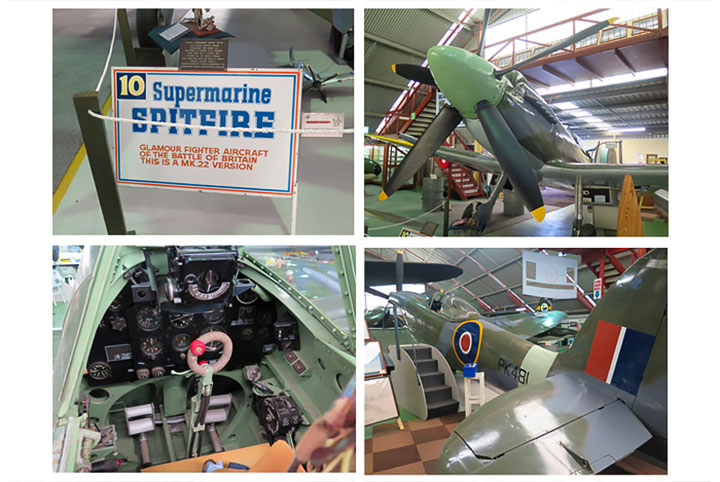
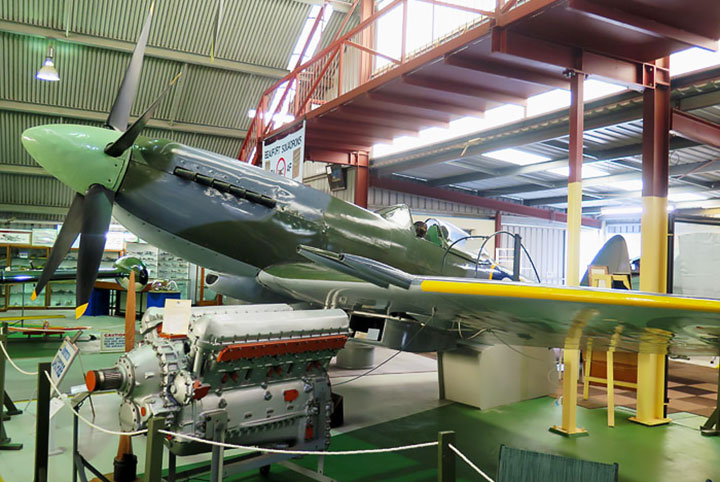
Hi guys,
I have 5 photographs of PK481 on display on Hove promenade (near the King Alfred centre) taken by myself c1957/8. There are 5 B&W contact prints and negatives. If you would like copies please let me know.
I understand the last production model Spitfire was the Mk24, which for the first time had a slightly altered wing shape and if memory serves, boosted ailerons for improved roll control at high speeds. The Rhodesian air force operated a number of these aircraft in the 1950’s, before the dry warm African climate, caused shrinkage of the wooden blade roots in the propeller hubs. Other mechanical problems were experienced as was the case in South Africa with Spitfires, as spares and other support slowly dried up. The new Vampire led jet age being all the rage, by this time.
Jack Mulloch, (Rhodesia’s version of Sir Tim Wallace), re-built a Spit Mk24, the only one flying but tragically he was killed in the 24, when he inadvertently, flew into a severe turbulence thunderstorm, during a photoshoot.
Interesting that for some reason Rolls Royce decided to make the Griffon engine rotate in the opposite direction to the Merlin…this lead to some interesting swings on take off apparently, when former Spit Mk IX pilots, jumped into a Mk XIV! Great to see this rare aircraft being displayed and stored under more friendly environmental conditions!
I lived in Rossmoyne, Western Australia for three-years, covering 1975, just up the road from the RAAF Association building where Spitfire Mk 22 – PK 481 – was displayed on the pole, and I assisted in the maintenance of it, and the re-building of its Rolls Royce Griffon engine.
I remember that Griffon when it was in its black with red Rolls Royce labelling – what a beast – such a shame we never got it fired-up.
I also helped maintain the Avro Lancaster bomber that used to be at Perth Airport, which I believe is likely to be the ‘Lanc’ behind Spitfire PK 481 at the Bull Creek museum in the photograph above.
Between 1980 and 1985 I served in the Royal Air Force in the UK at RAF Swinderby – Lincolnshire, RAF Shawbury – Shrewsbury, RAF Kinloss – Moray, Scotland, and RAF Stanley – Falkland Islands.
‘From Schooldays to Spitfire’ – the incredible biography of Reginald Joseph Mitchell – R.J. – the famous designer of many Supermarine flying boats, the S4, S5, S6, and S6B Schneider Trophy winning sea planes, and of course the Spitfire.
This great book is authored by Gordon Mitchell, R.J. Mitchell’s son, This book is a brilliant read if one is interested in anything to do with the Spitfire. I finished it just last week.
I consider myself very lucky to get to see this beautiful gal in person so often. Though, she is responsible for breaking my heart by showing me that I’m way too tall and my shoulders are too wide to ever have been a Spitfire pilot!